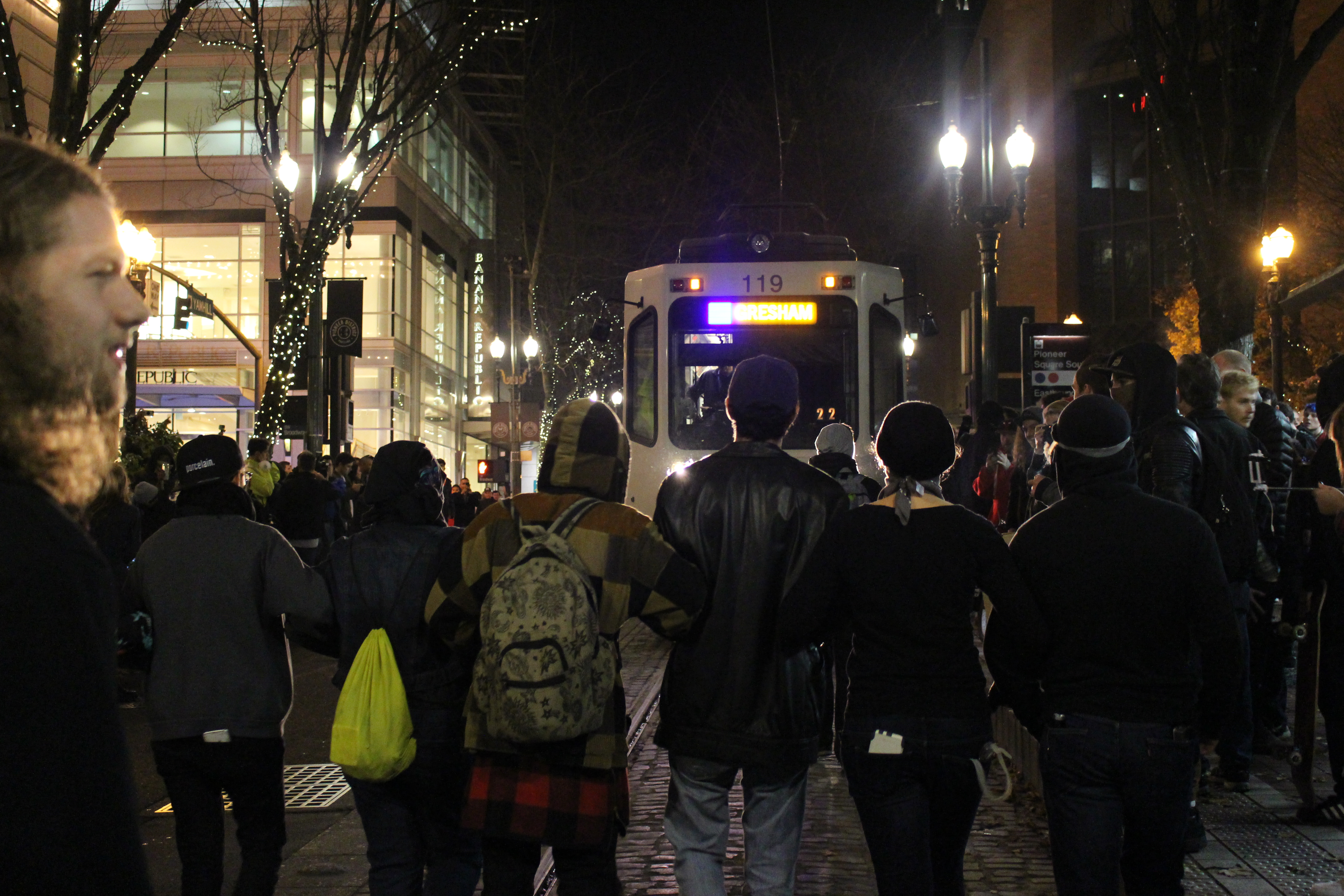Student safety ambassadors are the new “eyes and ears” of campus security. New hires, persistent vacancies, and policy changes are some of the most recent developments in CPSO. Interim President Stephen Percy answered questions about campus security during the quarterly student media conference on January 31. The Pacific Sentinel followed up with Interim Campus Public Safety/Police Chief Joe Schilling to discuss CPSO’s various ranks, responsibilities, hiring, and training as well as some new policy developments.
Background
Campus security was a highlighted topic during PSU’s Board of Trustees meeting last October. It was the first opportunity for members of the board and community to respond to recommendations made in a report released by the private campus security firm, Margolis Healy and Associates. The university commissioned the report in 2018, after armed campus police officers shot and killed Jason Washington, a legally-armed, black Navy veteran, outside of a bar on campus. The shooting revived scrutiny of the administration’s 2014 decision to arm campus police officers. Margolis Healy was asked to review PSU’s campus safety, solicit feedback from the community, and weigh in. The report found that 52 percent of students, faculty, staff, and community members surveyed said PSU should not have armed officers, but ultimately, the firm recommended PSU maintain its armed police officers.
Percy announced PSU would keep its armed officers during the rollout of his comprehensive safety plan, Safer Together. The initiative also formed a new rank in the Campus Public Safety Office (CPSO): the student safety ambassador.
Student Safety Ambassadors
Four students make up the first cohort of student safety ambassadors: Aseel Alattabi, Briana Benson, Liam Cole and Camila Oliveira. CPSO plans to hire six more for a total of 10 student safety ambassadors, and have two or three pairs patrolling weekdays between 2–10 p.m.
The role of a student safety ambassador is to be “the first point of contact and community presence,” according to the outline of Safer Together posted on President Percy’s website. “We’re not asking them to intervene,” Percy clarified in the press conference, “we’re asking them to be the eyes on the street.” The emphasis of student safety ambassadors, Chief Schilling reiterated, is to be the “eyes and ears” of campus security, alerting CPSO of whatever situation they come across on patrol, whether it’s criminal activity or busted light bulbs. But Schilling also sees the student safety ambassadors as community liaisons for CPSO that will be “a lot more approachable” to the community, “just from the standpoint of the historical perspective that law enforcement has.” Schilling hopes safety ambassadors can do some public outreach, too. “They have the inside scoop [about CPSO]. These folks can answer questions about what the training entails, or ‘What are you doing?’ or, ‘What’s your job?’ or, ‘What do you think about the police?’”
The students don yellow safety vests that read “Student Safety Ambassador” across the back, and patrol by milling about campus on weekdays between 6–10 p.m., targeting certain locations at certain times. For example, outside buildings when evening classes let out; someone may request a safety escort if they feel unsafe walking on campus at night. Percy clarified that student safety ambassadors are not currently part of the Campus Safety Escort Service and cannot be summoned to escort, but that may change in the future. They carry a messenger bag with a radio, and first aid supplies. In the future, Schilling says the ambassadors will carry tourniquets and emergency pressure dressings to manage traumatic injuries.
Student safety ambassadors undergo one month of training that covers CPR certification, CPSO policy and procedure orientation, and four hours of de-escalation instruction from Campus Police Officer Peter Ward. Schilling says Ward provides all officers with de-escalation training, or, as he calls it, “verbal judo.” Ward finished his instructor certification at the Board on Safety Training in California last year. Student safety ambassadors have also learned how to recognize signs of an opioid overdose and how to administer Narcan, an opioid overdose reversal agent, which they carry on patrols alongside first aid supplies
Campus Police Officers / Campus Public Safety Officers / Campus Dispatchers
In addition to the safety ambassadors, CPSO recently hired two new police officers (Kenan Powell and Francisco Saldivar), three public safety officers (Shannon Dix, Tyler Williams, and Nicholas Chase) and two dispatchers (Ashley Whitten and Jessica Dvorak).
Public safety officers respond to calls, provide assistance, escorts, and first aid. Sworn police officers, unlike public safety officers, carry a gun and have the authority to enforce and investigate criminal activity, like sexual assaults, on campus. While public safety officers go through a similar hiring process, sworn police officers are subject to a more extensive background check.
Campus safety is budgeted to have five more police officers and three more safety officers, for a total of ten each. Schilling said he will look to fill some of those vacancies sometime in the next fiscal year.
But police agencies across the nation are up against a workforce crisis and Portland is no exception. CPSO and the Portland Police Bureau (PPB) both have outstanding vacancies given low recruitment and retention. “Part of the struggle is just to make law enforcement attractive for folks. Because of the historical perspective going around law enforcement, it’s difficult to attract [people]” Schilling said. Those that do apply have to get through an “extensive, six-week-long background check.”
Kenan Powell worked in private security and as a correctional deputy in Clark County. Francisco Saldivar, a social worker for nearly 20 years, wanted to become a police officer so he clerked in the Multnomah County Courthouse to get law experience. They were two of four applicants chosen by a search committee for their criminal justice backgrounds.
Campus public safety officers are interviewed by a search committee and reviewed by the University Public Safety Oversight Committee (UPSOC) and the Police Review Committee before Schilling makes hiring decisions. Background checks disqualified the other applicants, cutting the pool in half. Once Saldivar and Powell were approved by the committees, Schilling hired them both.
Saldivar and Powell are in Salem for three weeks of training at the Department of Public Safety Standards and Training (DPSST) Academy, Oregon’s police academy. Once they complete CPSO’s in-house training (including de-escalation training from Officer Ward), the new police officers are considered ready for active duty.
Dispatchers are hired directly by CPSO without input from the committees. “They are more internal,” Percy said. Like all emergency dispatchers in Oregon, they are certified through the Basic Telecommunicator course at DPSST. PSU’s dispatchers work out of the Campus Public Safety Dispatch Center, which is staffed 24/7 and functions as “the central hub to Public Safety operations.” They assist callers in both emergency and non-emergency situations, like escort requests, and decide which agency—CPSO, PPB or the Portland Fire Department, for example—to send to aid a caller.
The two newest dispatchers, Jessica Dvorak and Ashley Whitten, have ties to the PSU community. Jessica Dvorak is a student in PSU’s master of technology and professional writing program. She became friends with CPSO officers while working at the front desk of PSU’s University Place Hotel. Even joining CPSO officers for Thanksgiving dinner and when they performed a welfare check on an agitated man that evening.
Ashley Whitten joined the U.S. Coast Guard after she graduated from Oregon State University and the U.S. Coast Guard Academy. Schilling added that she is Campus Public Safety Lieutenant Craig Whitten’s daughter. As a dispatcher, the younger Whitten decides which agency to send to respond to a call. Schilling suggested he addressed any possible conflict of interest influencing decision-making on the job. “That’s a conversation that I certainly had…with everybody involved about making sure those instances don’t occur.”
In a follow up conversation, Schilling said Lieutenant Whitten was not part of the selection process, nor does he supervise her within CPSO’s organizational structure. According to Schilling, CPSO curtails nepotism by having anyone on the search committee who has “any kind of personal involvement” with an applicant recuse themselves from the search committee’s interview, so “that relationship would not influence how those people are selected.”

illustrations by May Walker
CPSO and PPB
Before the rollout of Safer Together, Percy says he and his staff had been meeting with city officials, in part “to figure out the answer to a question: ‘Why don’t we use the Portland Police and call it a day?’” He says PPB reached out to encourage the university to retain its own armed police officers, and were concerned they wouldn’t be “as well-trained” to do campus public safety. PPB still wants to be in a partnership, Percy said. “We do work very closely together with them.”
Percy said that whether dispatchers send PPB or CPSO to a call depends largely on location, but sometimes campus boundaries are unclear. “If we need help, we can call and they will come.”
“Because the campus is the city and the city is the campus,” added Chris Broderick, Associate Vice President for Communications. “So the city responds to what happens on campus.”
Schilling clarified that there is an agreement that PPB officers would help if CPSO “didn’t have the staff or expertise to handle a particular call for service or an event.” He explained that CPSO helps PPB by taking “an occasional call that’s within our service district” if PPB is busy, though this does not happen routinely, he said.
According to CPSO’s website, when someone calls the campus dispatch, dispatchers “obtain the necessary information from the caller to provide an appropriate response.” In emergency situations, they work with PPB and the Portland Fire Department.
Although PPB and CPSO have a partnership, and although PSU shares “a large body of information with partner agencies in the Portland area,” PPB and CPSO are separate agencies representing different jurisdictions. Percy described CPSO as “its own unique entity to Portland State who collaborates with the City of Portland Police Bureau. So we have our own rules, our own policies. And we have our UPSOC—our University Public Safety Oversight Committee.” UPSOC is a “representative group of faculty, staff and students” that provides oversight, counsel and advise to CPSO leadership to improve campus safety.
PPB does not have an official “mutual aid agreement” with CPSO the way it does with some neighboring law enforcement agencies. Typical mutual aid agreements between law enforcement agencies, according to the U.S. Department of Justice, are “memorandums of understanding,” with the purpose of addressing “specific crime problems that cut across jurisdictional boundaries.” If there were a mutual aid agreement, Schilling says it would mean CPSO could be called to support police during an event, like a protest. “We don’t have that agreement, because we don’t have the capability of doing that.”
Schilling stays up on PPB policies. He keeps a copy of PPB’s use-of-force policy in a folder next to CPSO’s and makes his officers aware of any differences in case they work together in the field “because it behooves us to be…on the same page since we’re doing use of force within their jurisdiction.” If a Portland police officer provides CPSO coverage, “it behooves us to kind of be on the same page, so that we’re not doing something that’s completely different than what we’re doing or what they’re doing.“
Schilling says that while wording and procedures may differ, both agencies have policies based on the “overarching national standard that’s out there.”
The city does not weigh in on CPSO policy but Schilling will refer to PPB policy routinely “to make sure our policy is compatible.” He considered PPB when revising CPSO’s body camera policy. PPB officers do not use body cameras.
The revisions Schilling proposed to CPSO’s current body camera policy are based on the International Association of Chiefs of Police (IACP)’s model policy. The draft provided by Schilling resembles CPSO’s current version, and the most notable revision is a stipulation that says officers should review body camera footage before they finish writing a report “to ensure report accuracy.” Civil rights advocates advise against this in case officers use footage to write their report rather than describe what they actually saw. The provided draft has yet to be reviewed by general counsel or UPSOC.
The current body camera policy went into effect in March 2016. It was drafted by Lexipol, LLC, a company that Schilling says provides “the software interface to write a policy,” as well as, “best practice wording that can be incorporated into a policy.” CPSO will also refer to some of the video training available on an online forum called PoliceOne, a company owned by Lexipol.
Lexipol, LLC is a private, for-profit company that formed in 2003 and became the predominant force in law enforcement policy and practices across the nation in less than 15 years. In 2016, Law professors at UCLA published the first academic study of Lexipol and found that it services over 3,000 public agencies in thirty-five states. They criticized its business model of promoting policies as cost-effective risk management tools and its policymaking process that lacked transparency and public input. Lexipol claims to provide standardized policies that reflect court opinions, legislation and what it calls “best practices” in each state, “yet Lexipol has resisted efforts to craft policies that go beyond the minimum requirements of court decisions because policies might increase legal liability exposure.”
Both CPSO and PPB have consulted Lexipol for policies. It was revealed that PPB consulted Lexipol for their use-of-force policy in 2012, when the U.S. Department of Justice found that PPB “engaged in an unconstitutional pattern or practice of excessive force against people with mental illness.” Soon after the ruling, Lexipol concurred that PPB was not conforming to best practice as it relates to the investigation of force.
CPSO will be moving away from Lexipol and plans to overhaul all of its policies with Daigle Law Group. Schilling says the private company is “comparable” to Lexipol, but uses a “different format.” Schilling is switching because he was impressed by how Daigle Law Group incorporates national trends and case law into training and recommendations. According to Schilling, CPSO already receives a legal newsletter from Daigle Law Group “to determine, you know, case law and what practices and principles and policies we should be looking at.”





